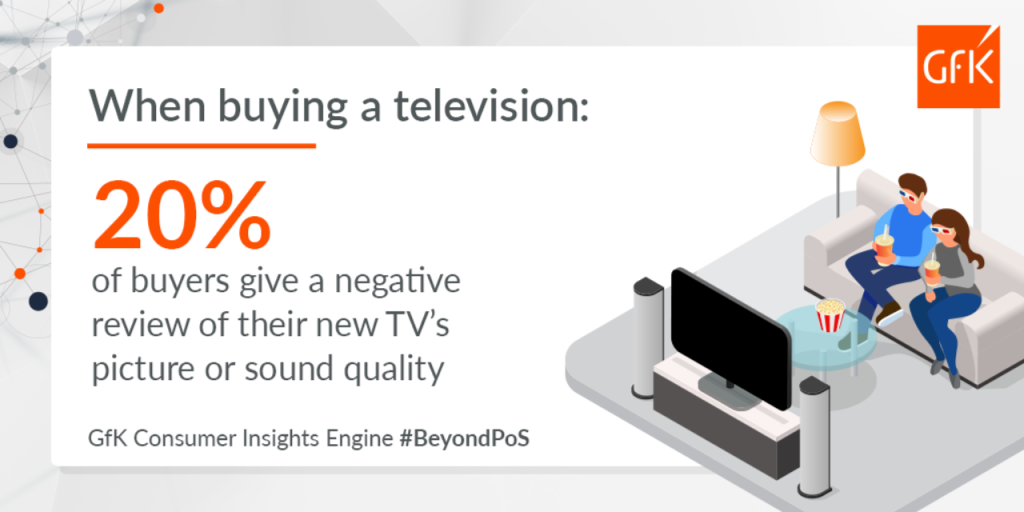‘Hygiene and user experience’ factors may affect a customer’s sentiment about a new product as much as its functional characteristics
Technology and consumer durables brands operate in an increasingly demanding retail landscape, characterized by margin pressure, fiercer competition, shorter product lifecycles and heightened customer expectations. To remain competitive in this challenging environment, retailers and manufacturers need access to both point of sale (POS) data and actionable consumer insights that enable them to make smarter and faster business decisions.
Over the course of this blog series, I have been looking at how the Consumer Journey module of the GfK Consumer Insights Engine delivers such insights and helps brands to better understand the consumer’s purchase journey. Following my previous post about the moment of purchase, I will this week turn to what our solution can tell you about early usage of a newly purchased tech or durable product.
Throughout the purchase journey consumers seek reassurance that they are making the right investment, especially on high ticket items such as TV’s. Using the Consumer Insights Engine to look at early usage gives us an insight as to whether or not the journey was ‘successful’ from the consumer perspective, i.e. after all the research, are they satisfied with the choice that they made? If not, it can have a negative impact, not only on their relationship with the brand they bought from, but also on the retailer they purchased from. Especially if the retailer played a highly influential role in the final decision.
Product managers, retail sales reps, marketers and operations departments can all benefit from knowing what customers think and say about a product once they are actually using it. The Consumer Journey module fuses data from our survey around early product experience and applies semantic analysis to retailer review data.
I am once again using the UK television market as an example, but our solution covers key consumer technology and durables categories across 13 major territories.
Our Consumer Journey module shows that UK television brands have an average net promoter score (NPS) of +34; 48% of consumers are happy with their purchase. When you compare this to the average NPS score of +29 across technology and consumer durables product categories in the UK, we can deduct that TV manufacturers are doing an adequate job of meeting consumer demands. However, as always is the case, they could do better.
With the right insights at hand, they could improve sentiment among the 52% of people who are passive about the products they bought or who are active brand detractors.
To get to the ‘right insights’ we collect review data from key retailer websites in each of our markets and apply artificial intelligence to provide sentiment-based intelligence into early usage and the product aspects that lead to memorable experiences. This gives us insights into the factors that matter to a UK purchaser who has just started to make use of a newly purchased television. Below outlines the net sentiment scores* for these factors:
- Value for money (96%)
- Easy to set up (87%)
- Great picture (86%)
- Happy with the purchase (83%)
- Picture quality (74%)
- Picture and sound (54%)
- Easy to use (21%)
- TV looks amazing (17%)
- Sound bar quality (11%)
(Source: Consumer Insights Engine Consumer Journey, Q1 2018 data for the TV category in multiple markets)
If you browse back to my previous post, you’ll see that functional factors such as size and product dimensions were key drivers of the consumer’s purchase earlier in the customer journey. However, once the consumer takes a brand-new television home, practical user experience and hygiene factors such as ease of set-up, connectivity with other products, and the smart TV capability all become an important part of their experience with the product.
As the low net sentiment for ease of use and aesthetics shows, brands should pay as much attention to the out of the box experience as they do to functional qualities such as screen size or support for UHD and HDR.

Picture and sound get the second highest number of mentions in product reviews. However, it is important to note that one in five (20%) of these reviews are negative. This highlights the importance of the performance of these factors to the UK purchasing consumer.
It’s also interesting to see how low net sentiment is around the quality of the sound bar. This indicates that this particular function is polarizing among consumers. When brands get it wrong, it reflects badly on them. However, when they get it right, it can create a great deal of positive sentiment about their product.
The combination of early usage survey data and sentiment-based analysis of review data in the GfK Consumer Insights Engine allows brands and retailers instant access to deeper insights that give a more complete understanding of consumer’s purchasing decisions, their experiences against those decisions, and how that reflects on their brand.
I invite you to look at our Consumer Insights Engine demo to see for yourself how it combines POS data with market research, and online consumer behavior data to offer you on-demand access to insights you can apply in your business.
*Net sentiment (net positive) is the positive scores minus the negative scores providing you with a more realistic view of the market. It’s designed to avoid over inflation and acknowledge any negatives.
Discover more consumer journey insights from the rest of our ‘Beyond Point of Sales Data’ blog series:
Beyond Point of Sale Data: Which consumer needs trigger the start of the purchase cycle?
Beyond Point of Sale Data: Search and evaluation in the consumer journey
Go Beyond Point of Sale Data: Understand the Moment of Purchase



